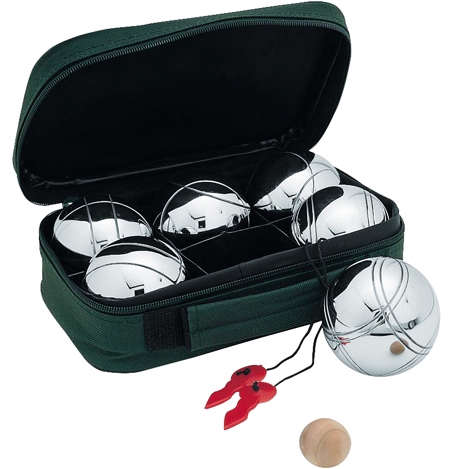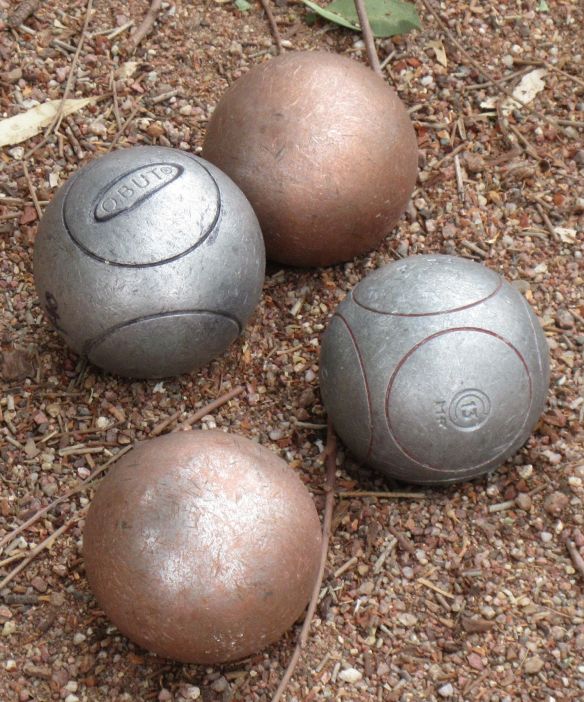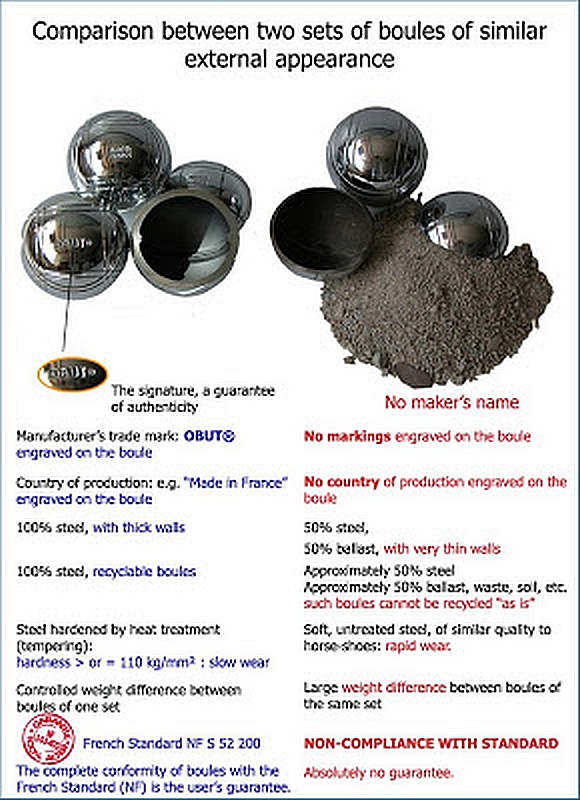[updated 2022-01-11] See also our post on buying boules.
One of the first questions that new players ask is— “What is the difference between leisure boules and competition boules?”
Probably the second most-frequently-asked question is— “I just bought this set of boules. Are they competition boules? Can I use them in an FIPJP-sanctioned competition? How can I tell whether this is a leisure boule or a competition boule?
What is the difference between leisure boules and competition boules?
The simple answer is that competition boules are certified by the international petanque federation (FIPJP) while leisure boules are not. You can read about the certification process HERE. But when most players ask the question, what they want to to know is— What are the physical differences between leisure boules and competition boules?
Let’s start by defining the expression “leisure boules” (or “recreational boules”). I’m going to use the expression “leisure boules” to refer to the kind of inexpensive “no name” boules manufactured in China that are available from many different vendors, including Petanque America. I will not treate Obut’s line of loisir inox boules as “leisure boules” (see below).

Some of the physical differences between leisure boules and competition boules are obvious. Competition boules come in a variety of sizes, weights, and striation patterns. That means that you can pick what suits you best. Leisure boules are basically a “one size fits all” affair.
Another obvious difference is price. Leisure boules are much cheaper than competition boules. Today (January 2022) in the United States a set of three Chinese leisure boules will cost you about $30. In comparison, you will pay between $90 and $120 for the least expensive competition boules from La Franc or Obut.
Inexpensive Chinese leisure boules typically have a very shiny, gloss chrome finish, like the chrome on a new car (see picture, above). That’s because they are made of carbon steel covered with a thin layer of nickel, covered by a thin layer of copper, covered by an exterior layer of chrome. The exterior chrome finish looks great, of course, but its purpose is to protect the underlying carbon steel and keep the boule from rusting. The nickel and copper layers allow the chrome to adhere to the carbon steel.
These intermediate layers can produce an interesting effect— if these boules are played with regularly, over time the chrome will slowly wear off, exposing the copper layer. The boules turn orange!

There are also differences that you can’t see.
Leisure boules use softer steel and are manufactured to lower standards. (That is what allows them to be made more cheaply than competition boules.) Competition boules are always hollow, but leisure boules are made of thinner steel than competition boules. Because there is less steel in a leisure boule, the manufacturer brings the boule up to proper weight by filling it with something, usually sand. Compared to a set of competition boules, a set of leisure boules will be less consistent in weight and balance.

Boules are made by welding two steel hemispheres together. If the weld cracks, water gets into the crack and rust starts to form. Eventually rust weakens the weld to the point that the boule breaks neatly in half along the weld. This is much more likely to happen to a leisure boule than a competition boule, because the quality of the welding is poorer and the thinner steel shell flexes more.

One consequences of filling leisure boules with sand is that— very rarely— they explode. It happened in 2016 in Germany, and in 2009 in Switzerland. When the Swiss studied the boules, it was discovered that the boules were filled with damp sand contaminated with iron filings. The water in the sand corroded the iron filings, producing hydrogen gas. Under the pressure of the hydrogen gas, the poorly-welded seam of one of the boules failed and the boule exploded. It literally blew its top. For more information on exploding leisure boules, see THIS.
None of this means that leisure boules are junk and that you should never purchase a set of leisure boules. Quite the contrary. Leisure boules are perfectly acceptable for casual or occasional play, or for practice. And because they are relatively cheap, we recommend them as the best choice for someone just starting to learn and play petanque.
Obut’s line of loisir inox boules occupies a unique niche (unique in both price and quality) somewhere between cheap Chinese leisure boules and competition boules. They are leisure boules; they are not certified for use in FIPJP-sanctioned competitions. But the quality of Obut leisure boules is much better than that of Chinese-made leisure boules. They are—
- hollow, not filled with sand.
- much higher quality, made of stainless steel (inox).
- more expensive (around $60 per set).
Note, however, that at least in the United States, they are actually more expensive than a set of Geologic competition boules.

